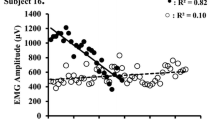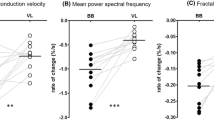Summary
Isometric flexion of the right elbow at 15% of the maximal voluntary contraction (MVC) was maintained to the limit of endurance (elbow angle 135°). The surface electromyogram (EMG) of the brachioradialis (BR) and biceps brachii (BB) muscles was recorded for calculation of conduction velocity (CV) by the cross-correlation method, and determination of median frequency (fm) and root mean square (rms) amplitude. Perceived exertion was rated for both muscles, and heart rate and blood pressure were measured. The EMG of ten brief 15% MVC contractions distributed over a 30-min recovery period was also recorded. Eleven males in their twenties volunteered for the investigation. The average endurance time was 906 (SD 419) s. Mean CV for the unfatigued muscles was 4.2 (SD 0.41) m·s−1 (BR), and 4.3 (SD 0.29) m·s−1 (BB). The contraction caused a significant decrease in CV of BR (12%,P<0.001) whereas CV variation of BB remained insignificant. Concurrently the meanf m of both muscles dropped to approximately 66% of their initial values and their average rms amplitudes grew by approximately 380% (BR and BB:P<0.001, both parameters). The 1st min of recovery lowered the rms amplitudes by approximately 60% (BR and BB:P<0.01), while thef m increased to approximately 88% of the initial recording (BR,P<0.01; BB,P<0.05). The accompanying small increases in CV were beyond the level of significance. Over the next 29 min a significant parallel restitution inf m and CV took place; changes inf m evidenced a simple one to one reflection of relative CV variation. A similar uncomplicated linear causality between relative changes in CV andf m was hypothesized for the endurance contraction. Consequently, the 12% CV decrease of the BR accounted for only one-third of the fatigue inducedf m reduction of 33%, while two-thirds were assumed to be attributable to centrally mediated regulatory interventions in motor unit (MU) performance. Independent of contributions from the virtually unchanged CV, thef m of the BB muscle decreased by 35%; from one subject exhibiting a remarkably manifest burst-type pattern of MU activity it is argued that synchronization/grouping of MU firing predominantly determined the power redistribution in the BB spectrum.
Similar content being viewed by others
References
Andreassen S, Arendt-Nielsen L (1987) Muscle fibre conduction velocity in motor units of the human anterior tibial muscle: a new size principle parameter. J Physiol 391:561–571
Arendt-Nielsen L, Mills KR, Forster A (1989) Changes in muscle fiber conduction velocity, mean power frequency, and mean EMG voltage during prolonged submaximal contractions. Muscle Nerve 12:493–497
Becher G, Mucke R, Kramer H, Drews I (1983) Studies on local muscular endurance capacity of isometric working muscles using electromyographic methods. Electromyogr Clin Neurophysiol 23:415–423
Bigland-Ritchie B, Johansson R, Lippold OCJ, Smith S, Woods JJ (1983a) Changes in motoneurone firing rates during sustained maximal voluntary contraction. J Physiol 340:335–346
Bigland-Ritchie B, Johansson R, Lippold OCJ, Woods JJ (1983b) Contractile speed and EMG changes during fatigue of sustained maximal voluntary contractions. J Neurophysiol 50:313–324
Blinowska A, Veroust J (1987) Low frequency power spectrum of the EMG signal. Electromyogr Clin Neurophysiol 27:349–353
Bonde-Petersen F (1960) Muscle training by static concentric and eccentric contractions. Acta Physiol Scand 48:406–416
Borg G (1982a) A category scale with ratio properties for intermodal and interindividual comparisons. In: Geissler HG, Petzold P (eds) Psychophysical judgement and the process of perception. North-Holland, Amsterdam, pp 25–34
Borg GAV (1982b) Psychophysical bases of perceived exertion. Med Sci Sports Exerc 14:377–381
Chaffin DB (1969) Electromyography — a method of measuring local muscle fatigue. J Meth Time Meas 14:29–36
Chaffin DB (1973) Localized muscle fatigue — definition and measurement. J Occup Med 15:346–354
Chaffin DB, Andersson GBJ (1984) Occupational biomechanics. Wiley, New York, pp 39–43, 324–329
Christensen H, Fuglsang-Frederiksen A (1988) Quantitative surface EMG during sustained and intermittent submaximal contractions. Electroencephalogr Clin Neurophysiol 70:239–247
Conover WJ (1980) Practical nonparametric statistics, 2nd edn. Wiley, New York, pp 278–309
Darcus HD (1953) A strain-gauge dynamometer for measuring the strength of muscle contraction and for re-educating muscles. Ann Rev Phys Med 1:163–176
Dimitrov GV, Lateva ZC, Dimitrova NA (1988) Effects of changes in assymetry, duration, and propagation velocity of the intracellular potential on the power spectrum of extracellular potentials produced by an excitable fiber. Electromyogr Clin Neurophysiol 28:93–100
Eberstein A, Beattie B (1985) Simultaneous measurement of muscle conduction velocity and EMG power spectrum changes during fatigue. Muscle Nerve 8:768–773
Elble RJ, Randall JE (1976) Motor-unit activity responsible for 8to 12-Hz component of human physiological finger tremor. J Neurophysiol 39:370–383
Fallentin N, Sidenius B, Jorgensen K (1985) Blood pressure, heart rate and EMG in low-level static contractions. Acta Physiol Scand 125:265–275
Färkkilä M, Pykkö I, Korhonen O, Starck J (1979) Hand grip forces during chain saw operation and vibration white finger in lumberjacks. Br J Ind Med 36:336–341
Garnet D, Maton B (1989) The fatigability of two agonistic muscles in human isometric voluntary submaximal contraction: an EMG study. 1. Assessment of muscular fatigue by means of surface EMG. Eur J Appl Physiol 58:361–368
Gollnick PD, Karlsson J, Piehl K, Saltin B (1974) Selective glycogen depletion in skeletal muscle fibres of man following sustained contractions. J Physiol 241:59–67
Gydikov A, Kosarov D, Dimitrov GV (1979) Length of the summated depolarized area and duration of the depolarizing and repolarizing processes in the motor unit under different conditions. Electromyogr Clin Neurophysiol 19:229–248
Hagberg M (1981) Muscular endurance and surface electromyogram in isometric and dynamic exercise. J Appl Physiol 51:l7
Hultman E, Söderlund K (1988) Glycogen degradation during isometric exercise at low contraction force. Eur J Appl Physiol 58:225–227
Karlsson J, Ollander B (1972) Muscle metabolites with exhaustive static exercise of different duration. Acta Physiol Scand 86:309–314
Karlsson J, Funderburk CF, Essen B, Lind AR (1975) Constituents of human muscle in isometric fatigue. J Appl Physiol 38:208–211
Kilbom A, Gamberale F, Persson J, Annwall G (1983) Physiological and psychological indices of fatigue during static contractions. Eur J Appl Physiol 50:179–193
Kramer H, Rhein A, Brauer D, Küchler G (1979) Changes in mechanical and bioelectrical muscular activity and in heart rate due to sustained voluntary isometric contractions and time required for recovery, II. Contractions at a constant force level. Electromyogr Clin Neurophysiol 19:389–397
Kranz H, Williams AM, Cassel J, Caddy DJ, Silberstein RB (1983) Factors determining the frequency content of the electromyogram. J Appl Physiol 55:392–399
Krogh-Lund C, Jorgensen K (1991) Changes in conduction velocity, median frequency, and root mean square-amplitude of the electromyogram during 25% maximal voluntary contraction of the triceps brachii muscle, to limit of endurance. Eur J Appl Physiol 63:60–69
Kuorinka I (1988) Restitution of EMG spectrum after muscle fatigue. Eur J Appl Physiol 57:311–315
Lindström LH, Magnusson RI (1977) Interpretation of myoelectric power spectra: a model and its applications. Proc IEEE 65:653–662
Lindström L, Magnusson R, Petersén I (1970) Muscular fatigue and action potential conduction velocity changes studied with frequency analysis of EMG signals. Electromyography 10:341–356
Lindström L, Kadefors R, Petersén I (1977) An electromyographic index for localized muscle fatigue. J Appl Physiol 43:750–754
Lippold OCJ, Redfearn JWT, Vučo J (1957) The rhythmical activity of groups of motor units in the voluntary contraction of muscle. J Physiol 137:473–487
Maton B, Bouisset S (1977) The distribution of activity among the muscles of a single group during isometric contraction. Eur J Appl Physiol 37:101–109
Maton B, Garnet D (1989) The fatigability of two agonistic muscles in human isometric voluntary submaximal contraction: an EMG study, II. Motor unit firing rate and recruitment. Eur J Appl Physiol 58:369–374
Merletti R, Sabbahi MA, De Luca CJ (1984) Median frequency of the myoelectric signal. Effects of muscle ischemia and cooling. Eur J Appl Physiol 52:258–265
Miller RG, Giannini D, Milner-Brown HS, Layzer RB, Koretsky AP, Hooper D, Weiner MW (1987) Effects of fatiguing exercise on high-energy phosphates, force, and EMG: evidence for three phases of recovery. Muscle Nerve 10:810–821
Moritani T, Muro M, Kijima A, Berry MJ (1986a) Intramuscular spike analysis during ramp force output and muscle fatigue. Electromyogr Clin Neurophysiol 26:147–160
Moritani T, Muro M, Nagata A (1986b) Intramuscular and surface electromyogram changes during muscle fatigue. J Appl Physiol 60:1179–1185
Mortimer JT, Magnusson R, Petersén I (1970) Conduction velocity in ischemic muscle: effect on EMG frequency spectrum. Am J Physiol 219:1324–1329
Naeije M, Zorn H (1983) Estimation of the action potential conduction velocity in human skeletal muscle using the surface EMG cross-correlation technique. Electromyogr Clin Neurophysiol 23:73–80
Pérés G, Maton B (1987) Validity of the muscle equivalent concept in human muscular isometric contractions at different elbow angles. Electromyogr Clin Neurophysiol 27:135–143
Rohmert W (1960) Ermittlung von Erholungspausen für statische Arbeit des Menschen. Int Z Angew Physiol Einschl Arbeitsphysiol 18:123–164
Rohmert W (1962) Untersuchung über Muskelermüdung and Arbeitsgestaltung. Beuth, Berlin, pp 1–90
Saito M, Mano T, Abe H, Iwase S (1986) Responses in muscle sympathetic nerve activity to sustained hand-grips of different tensions in humans. Eur J Appl Physiol 55:493–498
Saito M, Mano T, Iwase S (1989) Sympathetic nerve activity related to local fatigue sensation during static contraction. J Appl Physiol 67:980–984
Seals DR, Enoka RM (1989) Sympathetic activation is associated with increases in EMG during fatiguing exercise. J Appl Physiol 66:88–95
Sjogaard G, Kiens B, Jorgensen K, Saltin B (1986) Intramuscular pressure, EMG and blood flow during low-level prolonged static contraction in man. Acta Physiol Scand 128:475–484
Sollie G, Hermens HJ, Boon KL, Wallinga-De Jonge W, Zilvold G (1985a) The boundary conditions for measurement of the conduction velocity of muscle fibres with surface EMG. Electromyogr Clin Neurophysiol 25:45–56
Sollie G, Hermens HJ, Boon KL, Wallinga-De Jonge W, Zilvold G (1985b) The measurement of the conduction velocity of muscle fibres with surface EMG according to the cross-correlation method. Electromyogr Clin Neurophysiol 25:193–204
Urkowitz H (1983) Signal theory and random processes. Artech House, Dedham, Mass., USA, pp 95–121
Weiner MW, Moussavi RS, Baker AJ, Boska MD, Miller RG (1990) Constant relationships between force, phosphate concentration, and pH in muscles with differential fatigability. Neurology 40:1888–1893
Zwarts MJ, Arendt-Nielsen L (1988) The influence of force and circulation on average muscle fibre conduction velocity during local muscle fatigue. Eur J Appl Physiol 58:278–283
Author information
Authors and Affiliations
Rights and permissions
About this article
Cite this article
Krogh-Lund, C., Jørgensen, K. Modification of myo-electric power spectrum in fatigue from 15% maximal voluntary contraction of human elbow flexor muscles, to limit of endurance: reflection of conduction velocity variation and/or centrally mediated mechanisms?. Europ. J. Appl. Physiol. 64, 359–370 (1992). https://doi.org/10.1007/BF00636225
Accepted:
Issue Date:
DOI: https://doi.org/10.1007/BF00636225




